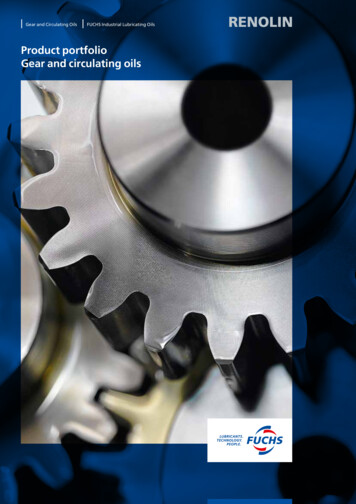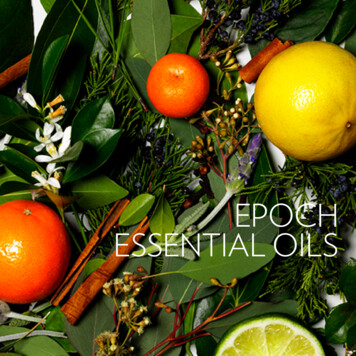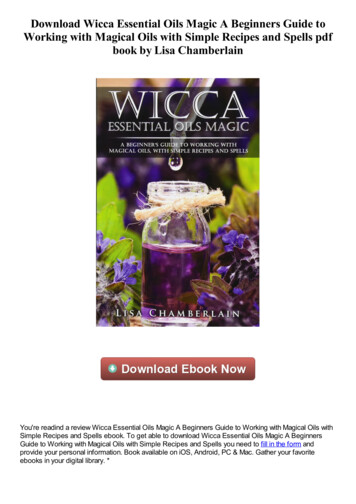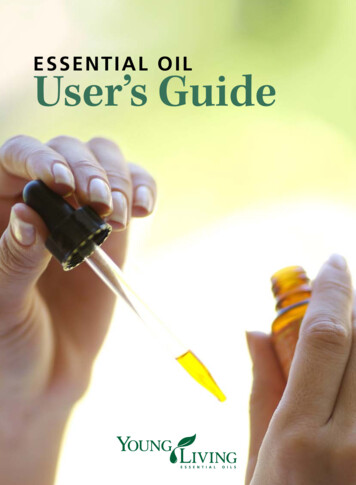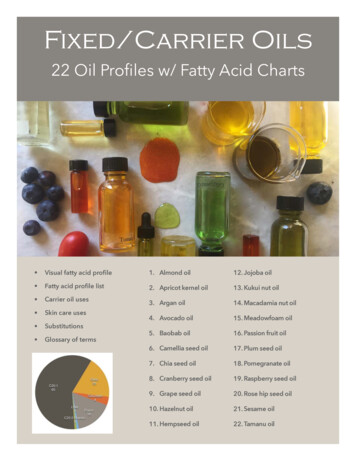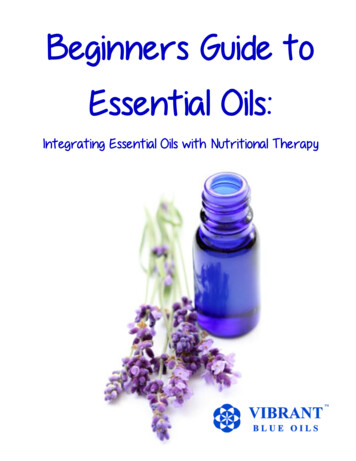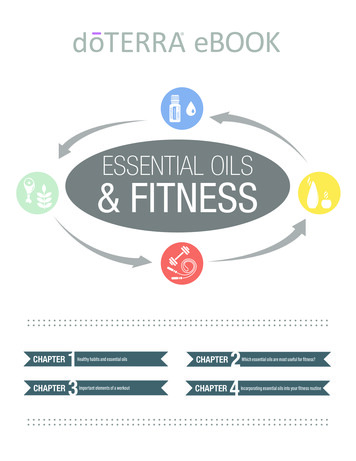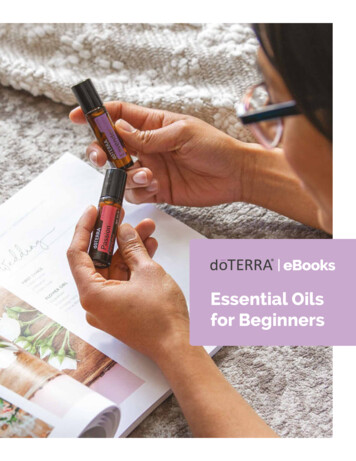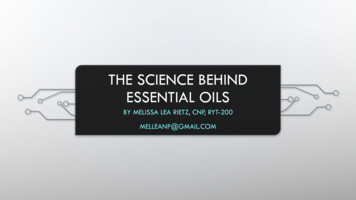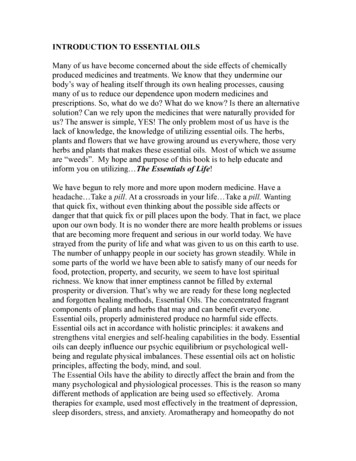
Transcription
INTRODUCTION TO ESSENTIAL OILSMany of us have become concerned about the side effects of chemicallyproduced medicines and treatments. We know that they undermine ourbody’s way of healing itself through its own healing processes, causingmany of us to reduce our dependence upon modern medicines andprescriptions. So, what do we do? What do we know? Is there an alternativesolution? Can we rely upon the medicines that were naturally provided forus? The answer is simple, YES! The only problem most of us have is thelack of knowledge, the knowledge of utilizing essential oils. The herbs,plants and flowers that we have growing around us everywhere, those veryherbs and plants that makes these essential oils. Most of which we assumeare “weeds”. My hope and purpose of this book is to help educate andinform you on utilizing The Essentials of Life!oilandherbhelpstheadrenals,whichisimpWe have begun to rely more and more upon modern medicine. Have aheadache Take a pill. At a crossroads in your life Take a pill. Wantingthat quick fix, without even thinking about the possible side affects ordanger that that quick fix or pill places upon the body. That in fact, we placeupon our own body. It is no wonder there are more health problems or issuesthat are becoming more frequent and serious in our world today. We havestrayed from the purity of life and what was given to us on this earth to use.The number of unhappy people in our society has grown steadily. While insome parts of the world we have been able to satisfy many of our needs forfood, protection, property, and security, we seem to have lost spiritualrichness. We know that inner emptiness cannot be filled by externalprosperity or diversion. That’s why we are ready for these long neglectedand forgotten healing methods, Essential Oils. The concentrated fragrantcomponents of plants and herbs that may and can benefit everyone.Essential oils, properly administered produce no harmful side effects.Essential oils act in accordance with holistic principles: it awakens andstrengthens vital energies and self-healing capabilities in the body. Essentialoils can deeply influence our psychic equilibrium or psychological wellbeing and regulate physical imbalances. These essential oils act on holisticprinciples, affecting the body, mind, and soul.The Essential Oils have the ability to directly affect the brain and from themany psychological and physiological processes. This is the reason so manydifferent methods of application are being used so effectively. Aromatherapies for example, used most effectively in the treatment of depression,sleep disorders, stress, and anxiety. Aromatherapy and homeopathy do not
mix well when used together. (The essential oils cancel out the effects ofhomeopathic remedies. Whether it is for the internal use of essential oils orthe external use, avoid them altogether during homeopathic treatment).The skin is the largest organ of the body. Absorbed by the skin, the essentialoils can reach the organs to be treated through the connective and lymphatictissues and the circulatory systems. Excretion of the oils from the body takesplace in the lungs and kidneys. Essential oils greatly compliment andsupport the skin. Applied in diluted forms, they are used for massage, baths,and compresses. But again, the effect is a holistic one. The body, mind andspirit benefit at the same time.Essential oils can be taken internally. This form of treatment belongs in thehands of an experienced therapist. Improper use could be very harmful toyour health, as with most highly concentrate items.WHAT EXACTLY IS AN ESSENTIAL OILEssential oils are highly concentrated oils extracted from various parts ofaromatic plants, flowers and trees. They are most commonly extracted bysteam distillation, a process whose origins may be traced back to ancientMesopotamia. Unlike vegetable oils like corn and safflower, essential oilsare very volatile and will evaporate if left in the open.The chemistry of essential oils is very complex. There are hundreds ofcomponents, such as terpenes, aldehydes and esters. Because of this anessential oil can be used to help a wide variety of disorders. Lavender hasantiseptic, antibacterial, antibiotic, antidepressant, analgesic, decongestant,and sedative properties. Due to their tiny molecular structure, essential oilsapplied to the skin can be easily absorbed into the bloodstream.Essential Oils also reach the bloodstream as a result of the oils themselvesbeing inhaled. When inhaled,, they pass through the tiny air sacs to thesurrounding blood capillaries by the process of diffusion. Once in thebloodstream the aromatic molecules interact with the body's chemistry.Aside from their medicinal properties, smelling an essential oil can upliftspirits, making you feel better. Out sense of smell is interrelated with thelimbic system, an area of the brain which is primarily concerned withemotion and memory. This influence of aromas on our psyches has led manyaromatherapists to practice a form of aromatherapy called “psychoaromatherapy”, using essential oils to enhance the moods and emotions.Holistic healing has long been concerned with looking at the causes andprevention of illness rather than fixing the symptoms. With holistic healingwe take responsibility for our own health. The use aromatherapy should be
in conjunction a healthy diet, lifestyle and exercise. Aromatherapy can beused in conjunction with most other forms of treatment includingpsychotherapy, nutritional counseling, medical herbalism and orthodoxmedicine. The use of aromatherapy as a stress reducer is most common, andwith so many wonderful essential oils to choose from everyone can body'sself- itisandbronchitis.How Do Essential Oils Work?By: D. Gary py is a phrase coined by Rene-Maurice Gattefosse, Ph.D., in1920, which was a French cosmetic chemist. While working in hislaboratory, he had an accident that resulted in a third degree thermal burn ofhis hand and forearm. He plunged his arm into a vat of lavender oil, thinkingthat it was water. To his surprise, the burning slowly decreased and thenstopped within a few moments. Over a period of time, with the continualapplication of lavender oil, the burn healed completely without a trace of a
scar. As a chemist, he analyzed the essential oil of lavender and discoveredthat it contained many substances referred to as chemical constituents orchemical properties. As a result of this, Dr. Gattefosse determined thatessential oils contained tremendous healing properties.Dr. Gattefosse shared his experience with his colleague and friend, Dr. JeanValnet, a medical doctor in Paris, France. During World War II, whileserving as a medical physician in the French Army at the China Wall,treating war victims, Dr. Valnet ran out of antibiotics, so he decided to tryusing essential oils. To his amazement, they had a powerful effect inreducing and even stopping the infection, and he was able to save many ofthe soldiers who otherwise might have died even with antibiotics.Dr. Valnet had two students who did their internship with him who wereresponsible for expanding his work, Dr. Paul Belaiche and Dr. Jean ClaudeLapraz. They discovered that essential oils contain antiviral, antibacterial,antifungal and antiseptic properties as well as being powerful oxygenatorswith the ability to deliver nutrients into the cells.For example, if you take a geranium plant and tear the leaf or the stem, aclear liquid will appear. This liquid is a very subtle and volatile essence thatexudes from the damaged tissues of the leaf. So it is with the human body.With a cut or scrape, we see the flow of blood from that opening in the skin.One significant difference between the blood and the plant liquid is thecolor. In the resin or oil being released from the plant, we find trace elementsof nutrients, hormones, enzymes, vitamins, minerals, antibodies, andantifungal, antibacterial, anti-infectious, antiseptic, and immune-stimulatingproperties. Another key agent found present in that resin is OXYGEN.Oxygen molecules are part of the chemical elements of the resin, such asalcohols, phenols, esters, sesquiterpenes, terpinols, etc., which togethercreates an essential oil.The plant releases the oil in order to clean the break, kill bacteria and startthe regeneration process. When blood is released because of broken skin, itis for the same purpose: to clean the wound, kill the bacteria, preventinfection, and begin the healing and regeneration process. A simplecomparison of the plant and the human body shows us a precise similarity,as both the oil and the blood are the transporters of the fundamental nutrientsnecessary to feed and nurture the cells.Furthermore, the essential oil has the ability in its chemical structure topenetrate the cell wall and transport oxygen and nutrients inside the cell,thus increasing cellular oxygen and giving more support to the immunesystem. Research has shown that with their immune-stimulating properties,essential oils enhance and support the building of the immune system,
whether they are inhaled or rubbed on the body topically. Even those whocontract a cold or the flu recover 70 percent faster using essential oils.It has been said that when essential oils are diffused in the home, they havethe ability to increase the atmospheric oxygen, as they release oxygenatingmolecules into the atmosphere. Oils increase ozone and negative ions in thehome, which inhibit bacteria growth. This prevents and destroys existingodors from mold, cigarettes, animals, etc. Essential oils have the electricalmagnetic attraction to fracture the molecular chain of chemicals and takethem out of the air, rendering them non-toxic to the body. Scientists inEuropean countries have found that essential oils will bond to metallics andchemicals and carry them out of the body, working as natural chelators,inhibiting these toxic substances from staying in the tissues. Essential oilsremove dust particles out of the air and, when diffused in the home, can bethe greatest air filtration system.Essential oils can be extracted from plants, trees, seeds, flowers, petals,stems, roots, bark, or even the whole plant. Today, about 200 different typesof oils are being distilled with several thousand chemical constituents andaromatic molecules that have been identified and registered. These aromaticSubstances and compounds within the oils will alter and change based onweather conditions, climate, temperatures, and distillation factors. Today, 98percent of essential oils are used in the perfume and cosmetic industry. In1991, only ½ percent was used for Aromatherapy. In 1993, 2 ½ percent wereproduced for Aromatherapy or for therapeutic and medicinal application.Essential oils are recognized as being the greatest substances for increasingcellular oxygen through their normal function. When applied to the body byrubbing on the feet, essential oils will travel throughout the body and affectevery cell, including the hair, within 20 minutes. They may have a lastingeffect for as long as five months from only one application. The oils do notbuild up and store in the body because they are very subtle and volatile andhave a high evaporation rate. Because of their chemical structure, they aremetabolized like other nutrients in the cells.One of the causes of disease in both the plant and the human body is theinability of nutrients to penetrate the cell wall, causing cell deterioration,leading to cell mutation, creating a host for bacteria and disease.The integral part of the nose responsible for odor detection is the olfactory,consisting of two membranes, one on each side of the mucous membranecovering the bony extension of the nose. The olfactory membranes are verytiny and are well protected by the casing of the nose. They contain about 800million nerve endings for processing and detecting odors. These nerveendings are triggered from a signal from the genes along the inside passage
of the nose. The olfactory hair-like nerves receive the micro-fine, vaporizedoil particles, carrying them along the axon of the nerve fibers, connectingthem with the synapse of the secondary neurons in the olfactory bulb. Theimpulses carried to the limbic system and the olfactory sensory center at thebase of the brain, pass between the pituitary and pineal gland and then to theamygdala, which is the memory center for fear and trauma. The impulsesthen travel to the gustatory center where the sensation of taste is perceived.Only in 1989 was it discovered that the amygdala plays a major role instoring and releasing emotional trauma, and only odor or fragrancestimulation has a profound affect in triggering a response with this gland. Dr.Joseph Ledoux, of the New York Medical University, feels that this could bemajor break-through in releasing emotional trauma.People who have turbinate problems, such as a deviated septum, polyps, orwho have had nose surgery, may have a very difficult or impossible timedetecting the complete odor. The same holds true for people who have worna lot of make-up, perfume and cologne or used hair sprays, hair colorings,perms and other products with synthetic odors. Many olfactory hairs respondto only one kind of odor molecule, and simultaneously others will respond toseveral different kinds of odors. This tells us that not all of the receptors arestimulated at the same time in the presence of odorous vapors.The olfactory nerves are very much like other nerves and organs in the body.They also respond to electrical signals and impulses that form codedmessages that are dispatched to various areas of the body. This may be whysome oil inhalation will increase endorphin, neurotransmitter and antibodyproduction. Fragrance is one of man's greatest enjoyments, bringing backmemories of past experience and creating a feeling of security, groundingand well-being."PICKING OUT ESSENTIAL OILSWhen a number of essential oils are offered at roughly the same price, youmay be certain that they are not pure. As you may have seen, essential oilsare produced widely using different methods. Some methods can be verysimple, but some requiring a great deal of effort and time. Some plants yielda lot of oil, some only a very little. All of these considerations are reflectedin the price you pay, which is also subject to some fluctuation. All of whichdepends upon the year of harvest. Unfortunately, some merchants often askas much for an essential oil that has been “stretched” or diluted as for onethat is pure. Since the term 100% natural or pure essential oil is notprotected, there is no guarantee of purity or quality. Some producers offer
essential oils that have been diluted with almond, grape seed, or othervegetable oils, but the label fails to mention this fact. That’s misleading.Meaning, there may be 100% pure essential oil in the bottle, but there mayalso be some other oil to carry the amount or stretch the oil. In some cases,the oils are stretched with mineral oils; usually petroleum or synthetic oils.As with most items and quality in purchases you make, “you get what youpay”! The essential oil is not really oil in the true sense of the word. Incontrast, fatty oils or commonly known as carrier oils (like jojoba, almondand salad oils), they are volatile. Fatty oils leave a mark when dropped on apiece of paper, while essential oils evaporate without a trace.Don’t hesitate to ask questions about the origins and quality of essential oils.The more you know the better off you are. If the merchant you are asking,has to look at the bottle for ingredients to see for themselves, you morelikely know more about that oil than they do (probably because you read itbefore they did). Do a little research for yourself. What I have found out thatworks for me about how to tell how pure the oil is is by the smell. Whenyou have an essential oil so concentrated, it’s overwhelming and powerful,to the point that you may not recognize the scent. It is the faint or dilutedsmell that we recognize. For example, Peppermint essential oil; when youtake the first smell of the peppermint essential oil, it is so overwhelming andpowerful that you don’t recognize that it is the peppermint essential oil. It isthe lingering smell that you realize, “Hey that smelled like Peppermint”.When looking to purchase essential oils, put this method to test! Find out foryourself. Another method I have found that works is with water. Water andoil do not mix. Oil will float on top of water. Place 1 drop of the essential oilin water. If it floats, then you know it is not pure and is diluted. You willnotice in the water (if the essential oil is pure), which is water and which isthe essential oil. Water and pure essential oils have a different moleculemake up, but they do mix. I have not found an essential oil as great ofquality as the Primavera Life Essential Oils and Shirley Price.
percent of essential oils are used in the perfume and cosmetic industry. In 1991, only ½ percent was used for Aromatherapy. In 1993, 2 ½ percent were produced for Aromatherapy or for therapeutic and medicinal application. Essential oils are recognized as being the greatest substances for
